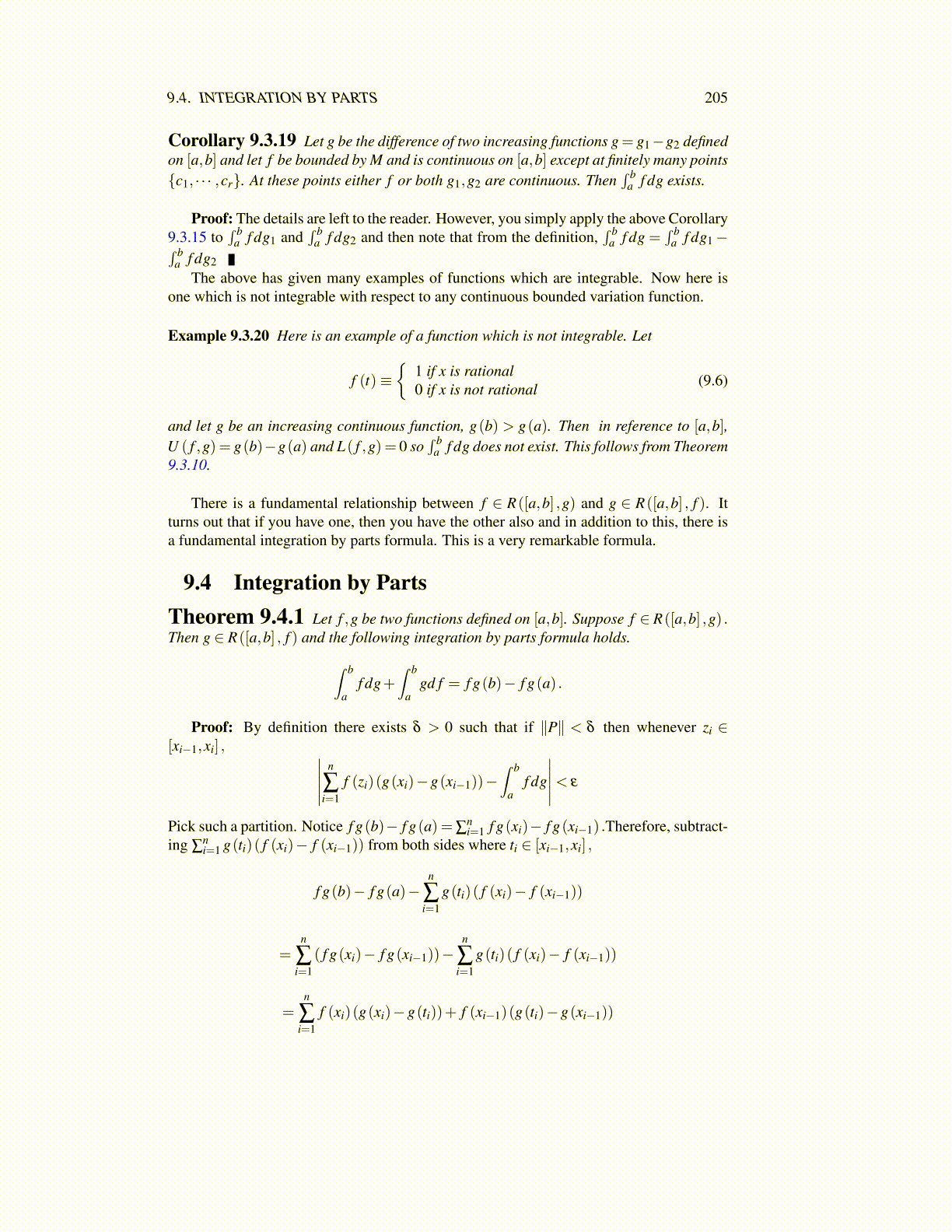
9.4. INTEGRATION BY PARTS 205
having real values. For this case, there is a much easier argument based on the mean valuetheorem.
In the assumptions for the following Proposition, it is easier to simply assume that g′ (x)exists and g′ is continuous on [a,b] where g′ (a) ,g′ (b) are defined as appropriate one sidedderivatives, but in the interest of generality, it is only assumed in the following that g′ (t)exists on (a,b) and is continuous on [a,b]. However, giving the condition on [a,b] is likelyeasier to remember and will suffice in all typical situations.
Proposition 9.4.3 Let g be real valued, continuous on [a,b] , and have a derivativewhich is continuous and bounded on (a,b). Then g has finite total variation and for fcontinuous, ∫ b
af (t)dg(t) =
∫ b
af (t)g′ (t)dt,
the integral on the right existing because t → f (t)g′ (t) is continuous on (a,b) , bounded,and γ (t)≡ t is continuous at the endpoints, Corollary 9.3.15.
Proof: First consider the claim that g has finite total variation. Let a = x0 < x1 < · · ·<xn = b. By the mean value theorem,
n
∑i=1|g(ti)−g(ti−1)|=
n
∑i=1
∣∣g′ (si)∣∣(ti− ti−1)≤max
{∣∣g′ (x)∣∣ : x ∈ [a,b]}(b−a) .
Thus V[a,b] (g)< ∞.Now, by Theorem 9.4.1,
∫ ba f (t)g′ (t)dt,
∫ ba f (t)dg(t) both exist. Therefore, there ex-
ists a δ such that if ||P||< δ , then letting P be {x0, · · · ,xn} ,∣∣∣∣∣ n
∑i=1
f (ui)(g(xi)−g(xi−1))−∫ b
af (t)dg(t)
∣∣∣∣∣ < ε,∣∣∣∣∣ n
∑i=1
f (ui)g′ (ui)(xi− xi−1)−∫ b
af (t)g′ (t)dt
∣∣∣∣∣ < ε
for any choice of ui ∈ [xi−1,xi]. But in the first expression, the mean value theorem impliesg(xi)−g(xi−1) = g′ (vi)(xi− xi−1) for some vi ∈ (xi−1,xi). Let ui = vi in the top inequalityto obtain ∣∣∣∣∣ n
∑i=1
f (vi)(g(xi)−g(xi−1))−∫ b
af (t)dg(t)
∣∣∣∣∣=
∣∣∣∣∣ n
∑i=1
f (vi)g′ (vi)(xi− xi−1)−∫ b
af (t)dg(t)
∣∣∣∣∣< ε
Then let ui = vi in the bottom inequality as well to obtain∣∣∣∣∫ b
af (t)dg(t)−
∫ b
af (t)g′ (t)dt
∣∣∣∣≤∣∣∣∣∣∫ b
af (t)dg(t)−
n
∑i=1
f (vi)g′ (vi)(xi− xi−1)
∣∣∣∣∣+
∣∣∣∣∣ n
∑i=1
f (vi)g′ (vi)(xi− xi−1)−n
∑i=1
f (vi)(g(xi)−g(xi−1))
∣∣∣∣∣